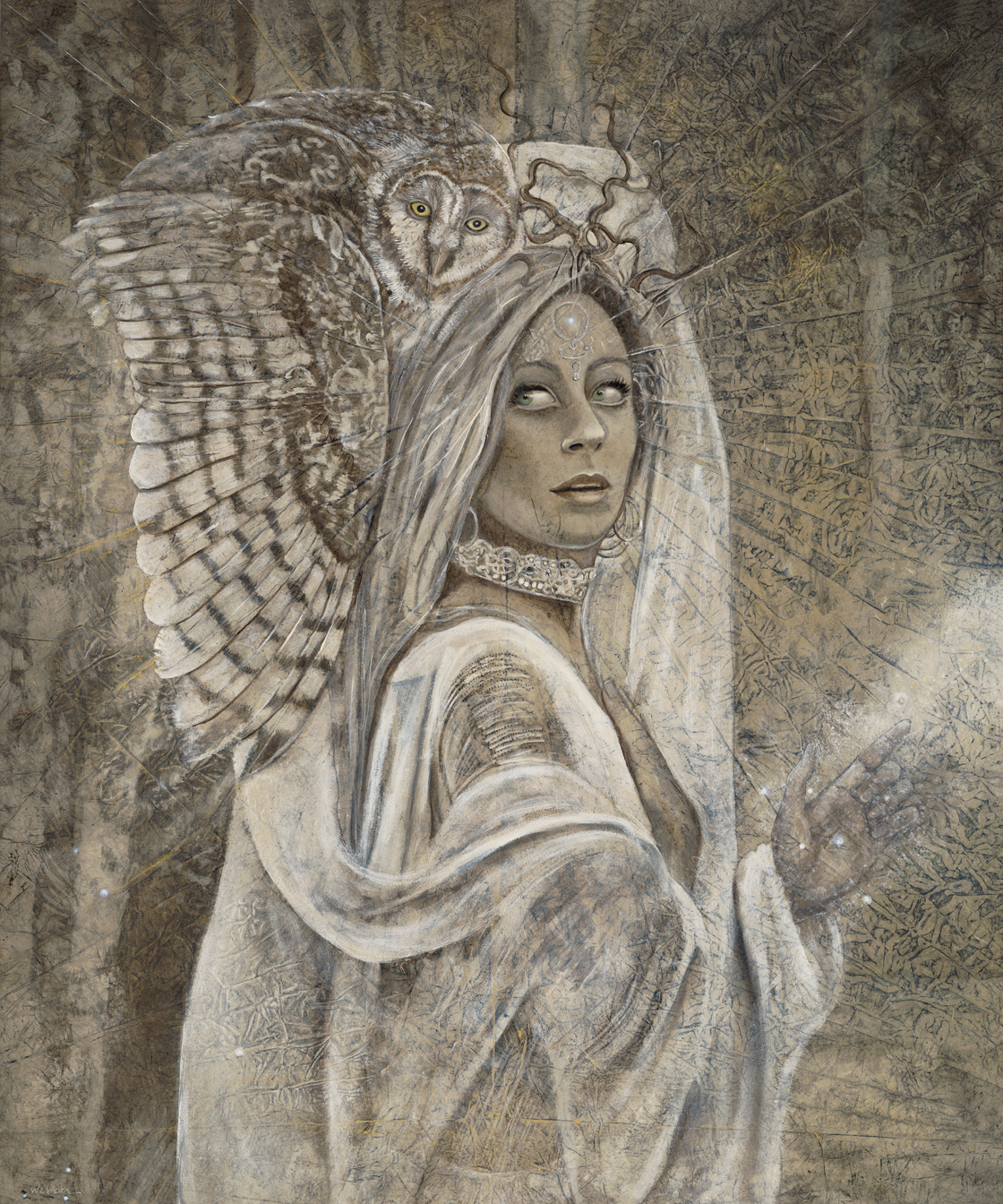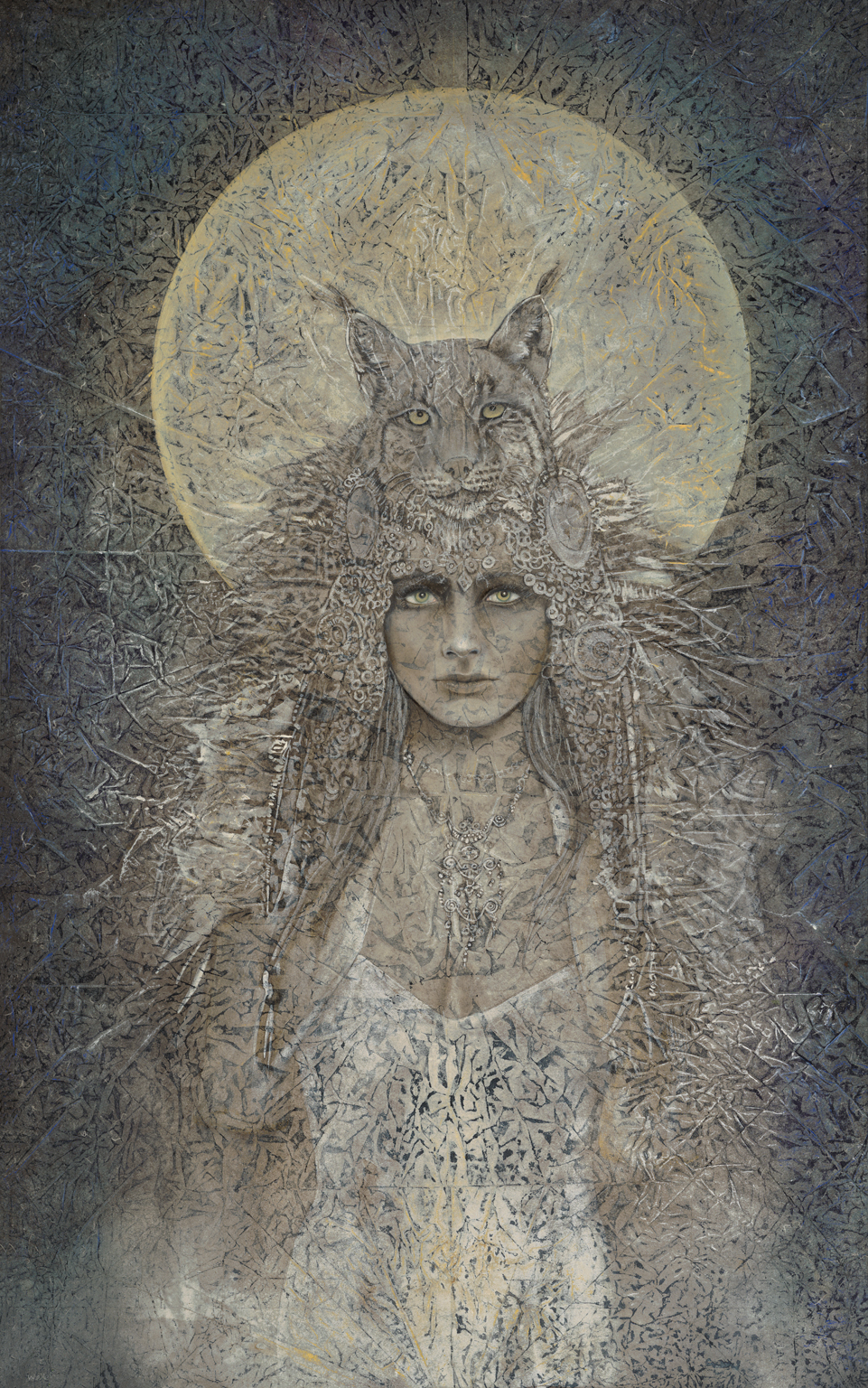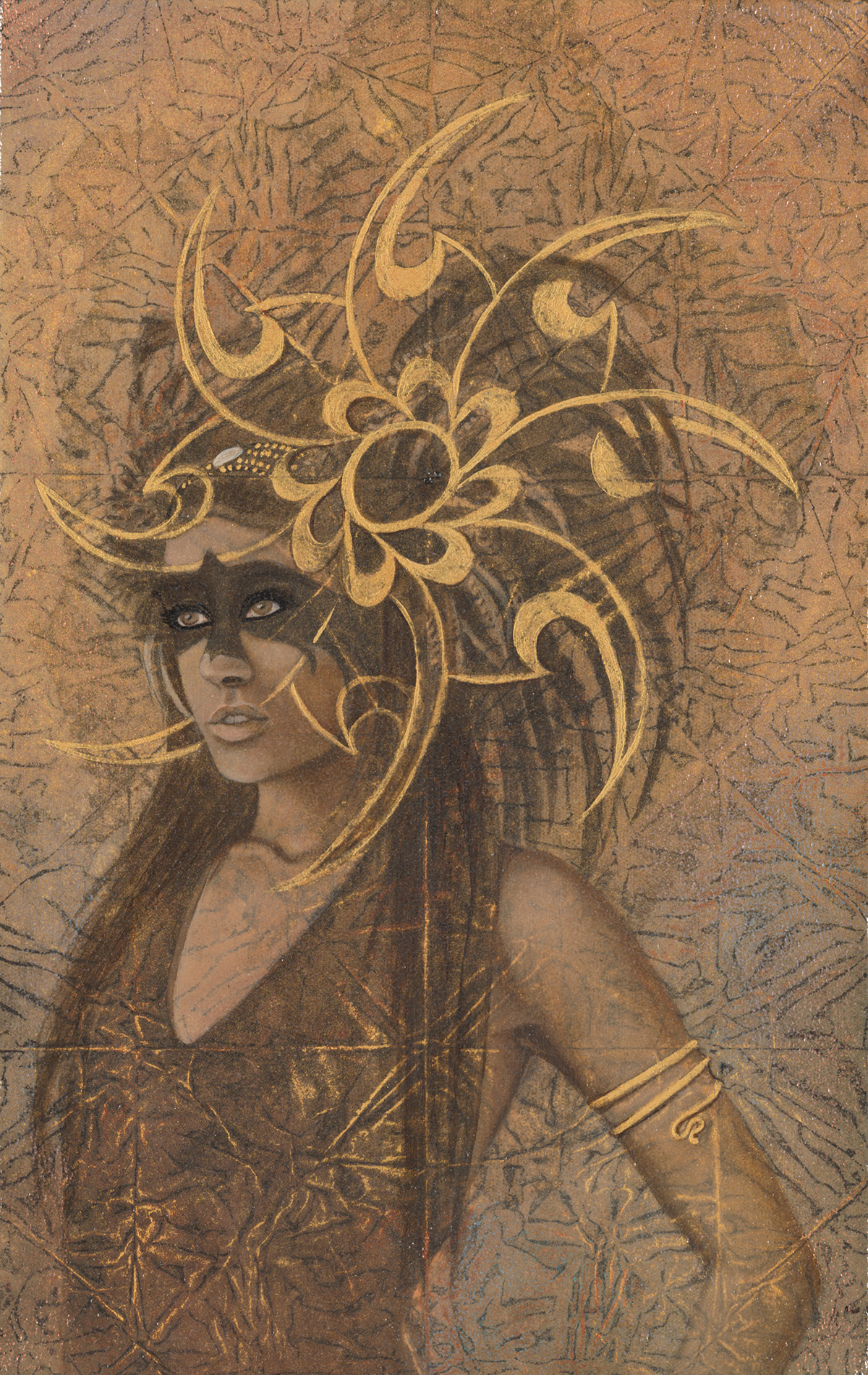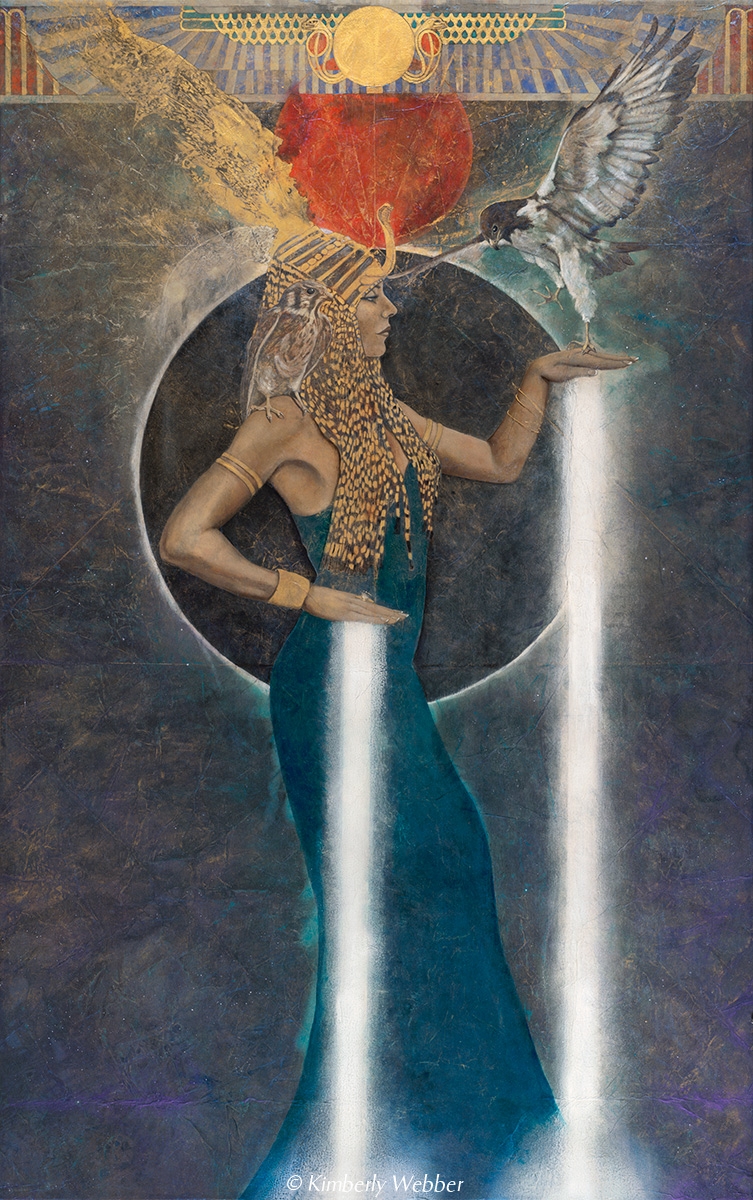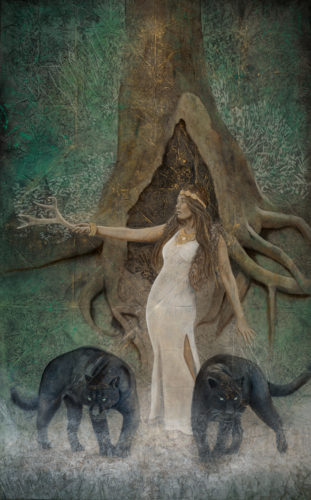Biography
In February 2019, New Mexico painter Kimberly Webber embarked on one of the most extraordinary pilgrimages of her 25 year career
Traveling to the Vatican from her longtime home in the Sangre De Cristo Mountains, she presented “Pia Mater”, an original 24” x 18” oil painting of Mother Mary, to Pope Francis. Representing the beloved Divine Mother archetype and conveying her devotion, compassion and love as well as the gravitas of today’s modern world. This recent journey is the latest milestone in a multi-faceted life that’s taken the painter all around the world in search of organic materials, minerals and earth pigments to use in her works. On her travels, Webber has also discovered and fused ancient inspirations in artistic technique from Europe and Asia, and partaken in deeply immersive experiences with nature to create what she calls “Contemporary Symbolist paintings, modern magical realism rooted in antiquity.” As part of Webber’s research for her 15 foot painting “Ocean’s Call,” currently exhibited on Pier 39 at the Aquarium of the Bay in San Francisco, the painter traveled to the South Pacific island of Tonga and swam with humpback whales and their babies in the remote and open ocean. She has sourced pure Naples Yellow in Italy and indigo blue in Nubia, along the Nile in Egypt “in the land of the goddess Isis.” The painter’s expansive collection, accumulated via travels and trade, includes collected minerals from Jerusalem and the Dead Sea region of Jordan, Turkey, India, Mesopotamia, the Pacific Islands, South America and Siberia. Closer to home, she’s collected mica flake rock in New Mexico’s abandoned mica mines and Abiqui red and white earth. In every place the artist travels, she seeks out pigments native to that region. The ancient temples in many of these regions are situated along the earth’s meridian systems as portals to the cultures of ancient people and modern pilgrims alike. Sacred sight experts and collectors who live with the orignal paintings have told the painter that the works she creates from these raw materials are like portable temples themselves.
Created in a large adobe studio environment that Webber has created as an interactive place of meditation and prayer, the painter’s works reflect her training in both Eastern and Western classical painting techniques
They are living, breathing expressions of ancient dreams, the mystery, power and magic of the natural world and the realms of the archetypes who reside in what Carl Jung called our collective super-consciousness. While all painters hope that their creations will live on beyond their lifetimes to inspire the hopes and dreams of future generations, Webber has a distinct sense of how that will manifest as she attends to the details of creating archival stability in each painting. “The materials I work with carry frequencies of intelligence, and there is subtle medicine embodied in the materials that can impact the viewer and planet as a whole,” the painter says. “When I am working on a painting, I am always asking for my personal story and ego to get out of the way of the emerging energy. It’s not about me. I am simply a conduit through which the messages are condensing down into the third dimension of the physical world to become something that people can view and interact with.”
“Often,” she adds, “when I am outside in the summer, mounting the paintings and transitioning them from rice paper and water based gum Arabic under-paintings into oil paintings, I get the distinct sensation of future generations looking at and experiencing the work. Through this, they are able to tell what was happening at this time, in our current time, on the planet, as if the painting is some kind of an inter-dimensional portal. Through all its many stages and processes, painting is a highly spiritual endeavor for me, with a surreal feeling of being in multiple times at once.”
The Setting
While working on her BFA in Painting from Ohio Wesleyan University in her native Ohio, Webber also studied in Florence, Italy and New York City.
After graduating Magna Cum Laude, the painter moved west and immersed herself in the wilderness of Northern California, returning to a deep inner knowing centered in the land. While living close to the earth in the Redwood Forest, she studied with a female shaman. In late 1992/early 1993, she was drawn to Taos, a town 7,500 feet above sea level 45 minutes south of the Colorado border at the southern end of the Rockies.“I had never been to Taos, but was undeniably being called to this land for reasons that eluded my logical mind. I packed up my tipi in a pickup truck and drove here,” Webber says. “Within 24 hours of arriving, the tipi was set up and I had worked out a trade arrangement with Rick and Terry Klein at New Buffalo for my tipi space in Hondo and studio space on Lama Mountain. The wide open vistas, huge sky and pristine wilderness affected me immediately and permanently. The land here nurtures my creative vision and the community here inspires me,” the painter adds. “I am blessed with an incredible circle of friends and colleagues from all three facets of Taos’ tri-cultural community. The traditional agricultural and spiritual ties with the land are what speak most deeply to my soul. The connection to the lifeblood of the acequias and the food and culture that result from the water are ancient, simple and profound. I love the water, the sky, the mountains, the quietude and the immense creative spirit of the people of Taos. I am so grateful to live and paint here.” Webber lives and paints in a traditional/historic adobe compound which was originally part of the legendary San Francisco de Asis Mission Church Plaza, an architecturally significant church on the main plaza of Ranchos de Taos. The home is an old adobe structure (remodeled by the artist). The historic St. Francis Church, built in the late 1700’s, was the subject of paintings by Georgia O’Keefe and photographs by Ansel Adams. The St. Francis Church and parish remain a central and beloved part of the Ranchos and Taos communities.
Webber has two painting studios. The main one is a large, open space, partially submerged in the earth, with high ceilings and massive windows which offer a majestic view of the Sangre De Cristos Mountains (which includes New Mexico’s highest peak of 13,167 feet).
Outside the painter’s home and studio are traditional flood irrigation ditches that have served the property since the 1700’s. The property has mature trees, peonies, roses, irises, gardens and many heirloom fruit trees including apricot, mulberry, apple, pear and plum. The unique weather patterns of Northern New Mexico inspire the painter to focus on different elements of her work depending on the seasons. During the cold, snowy winter, she draws and works with non-oil based materials like charcoal, gum Arabic and pigments in water based formulas. In the summer, she’s generally mounting and transitioning from drawing to painting, while in the fall she’s doing oil glazing and exhibiting in galleries. Then in early winter, the painter’s back to the dreaming and composing part and the cycle begins again. In her early days in Taos, Webber met abstract painter KC Tebbutt, who introduced her to the rice paper technique. Tebbutt talks about “the way combinations of ancient knowledge pass through the circle of creative innovation that comprise spiritual/metaphysical adventures within the surfaces of the works on Chinese rice paper.” Tebbutt passed along to her what he learned as a student of Lin Chien Shih, a master of the ancient Chinese rice paper and calligraphy technique. Prior to her exposure to these ancient techniques and concepts, the painter’s focus – very much informed by her formal art school training – was phantasmagorical and dream based. Webber and Tebbutt are colleagues today in the exploration of bio-photonic, or light responsive, paintings.
Alchemy
In her description of her “Pia Mater” painting, Webber explains the materials as “rice paper, earth pigment, encaustic and oil on panel” and the palette as “comprised of traditional pure mineral pigments, including Egyptian Azurite, lapis, manganese violet, malachite, mica, marble powder and pure 24kt gold.”
These are just some of the materials used by Webber, an alchemist painter who can often be found heating different mixtures to create the exact colors and textures the paintings require. She is especially fond of what she calls “The Formula”, a recipe that was discovered in one of Leonardo Da Vinci’s sketchbooks. Filling her studio with a beautiful fragrance of the alpine forest as it cooks upon the stove, it’s a combination of pure beeswax, Linseed oil and mastic pitch, a tree resin that only grows above a certain altitude in Europe. The mastic pitch has a rare quality to it that is more refined than Damar pitch and has a clear, golden essence to it. In many ways, the formula is literally gold. “I am interested in natural materials not only for esoteric and aesthetic reasons, but because the finer frequencies they embody have helped works by artists endure in a near pristine state over the centuries,” she says. The painter uses natural brushes with all different types of animal hair – wolf, horse, rabbit, etc. – which is old school Asian practice as well. The spirit of the animal inspires the brush stroke and each brush has a totally different quality. Webber’s consciousness about “archival stability” extends to her attentiveness to the details of the foundations of the paintings and their substrates. Of primary importance is the quality of the pine and oak in the panel strainers which are the ground of the paintings. The painter engages the services of “Artisan Santa Fe” to make the custom wood and aluminum stretcher systems (that won’t warp) for the large paintings.
Archetypes
Dictionary.com defines “archetype” as “the original pattern or model from which all things of the same kind are copied or on which they are based.
In Jungian psychology, it’s a collectively inherited unconscious idea, pattern of thought, image, etc. universally present in individual psyches. As expressed in Carl Jung’s book “Archetypes and the Collective Unconscious”, archetypes involve profound attitudes toward man’s existence and intimate value through which very many people have found a new significance in their lives.” Connecting to both the traditional and Jungian definitions of the term, the archetypal figures in Webber’s paintings appear through organic abstraction patterns. Icons of the deep subconscious, they materialize in the fertile multidimensional ground she lays as guides who help humanity to remember, to envision, to actualize and to heal. In the painter’s artist statement, she says, “Each viewer’s interpretation is unique and important, hence the term interpretive symbology that my colleagues and I have created to describe the phenomena of multiple perspectives, experiences and reactions to a single work of art. This is how archetypes function. They change, shift, bend and adapt to the infinite now, to our current issues and scenarios, and to the viewer’s own perspective.” Each series Webber creates is inspired by something unique. Sometimes, they are inspired by events happening in the external world. Sometimes the images appear straight out of the dream state. At other junctures, the painter may be inspired by a friend/model or by specific impressions, as in the Mary Magdalene or Sophia concepts being prominent “in the global awareness.” Animals, nature and priestess archetypes are definite connecting lines within the painter’s series. Webber’s INITIATION series, which explores the strength of the animal-human bond, connects with important issues around endangered species. One of its paintings, “Itsitva,” tackles both symbologies simultaneously, depicting a tiger merging with a feminine archetype. It was used to raise funds for SaveTigersNow.org, a global campaign by World Wildlife Fund and Leonardo Di Caprio that aims to double the number of wild tigers by 2022. Another series, EMPOWERMENT, featured archetypes associated with trees and the forest.
Origins
Though Webber’s biographies as a painter always include the moment her grandmother gifted her with her first set of paints at age 3, her childhood growing up in the country in Ohio was also marked by a passion for music and horseback riding.
She began learning to read sheet music and play piano at age five, and still plays music today, years after learning to play flute, French horn and later, percussion in her early 20’s in Santa Cruz, CA. She still performs on occasion with other musicians, collectively creating audio visual environments with music, “tri-stream” light projections and other performers. From the time she first got on a horse at age six, she rode nearly every day until she was 18, and was also competing in hunter/jumper and dressage events.The painter correlates her passion for bringing awareness to overturning the mass extinction of animals to her personal childhood connections to animals and nature. One of the homes her family lived in backed up to a woodland forest, and another had a 50 acre heirloom fruit orchard – and some of her fondest memories find her playing in the forest or out in the country on horseback. She began exhibiting her paintings as a teenager, and at 18 was selected for an Ohio State Governor’s Award of Excellence and also earned a scholarship to study painting at Ohio Wesleyan University based on her portfolio. Her works during this time were political, intense and combined a variety of media, including film and television. “Living out in the ancient Redwoods after graduating from college played an important role in helping me discover my artistic vision as a painter,” says Webber. “I had been doing politically oriented work to that point, painting large explicit and graphic images that included going into slaughterhouses and filming. I was making life-size panel paintings and running footage as part of the installations. It was all very hardcore. A bit Sue Coe inspired but even more graphic. I ultimately decided to focus on works that had the power to inspire and uplift people. And as I learned, what we focus on grows and expands. I no longer wanted to create paintings that had negative or violent content. It is about cultivating images and concepts that are uplifting and activating. Work that opens up the viewer’s imagination and vision. Essentially my practice changed from shocking people awake to endeavoring to inspire them with beauty.”
–By Jonathan Widran, April 2019
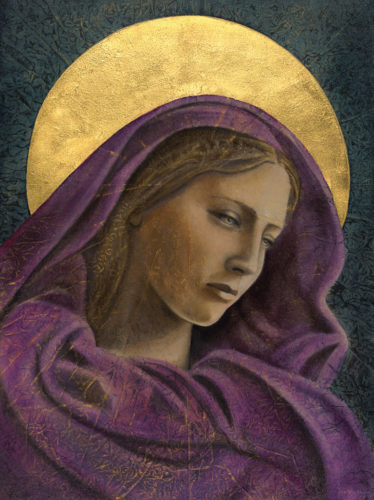
“Contemporary
Symbolist paintings, modern magical realism rooted in antiquity.”
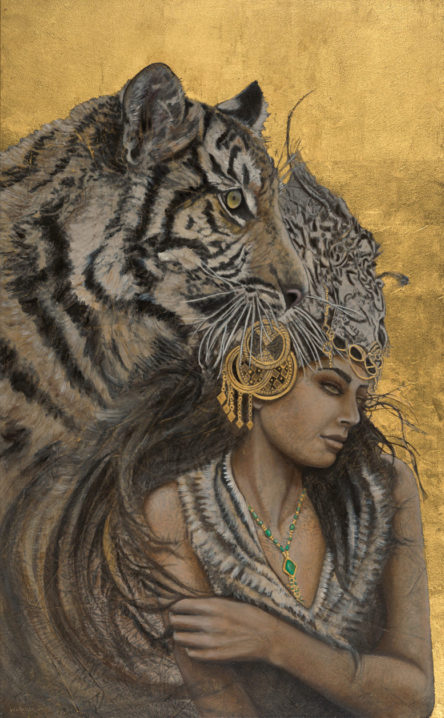
“Simulataneous planes of existence, with a surreal feeling of being in multiple times at once”
“The land here nurtures my creative vision and the community here inspires me”
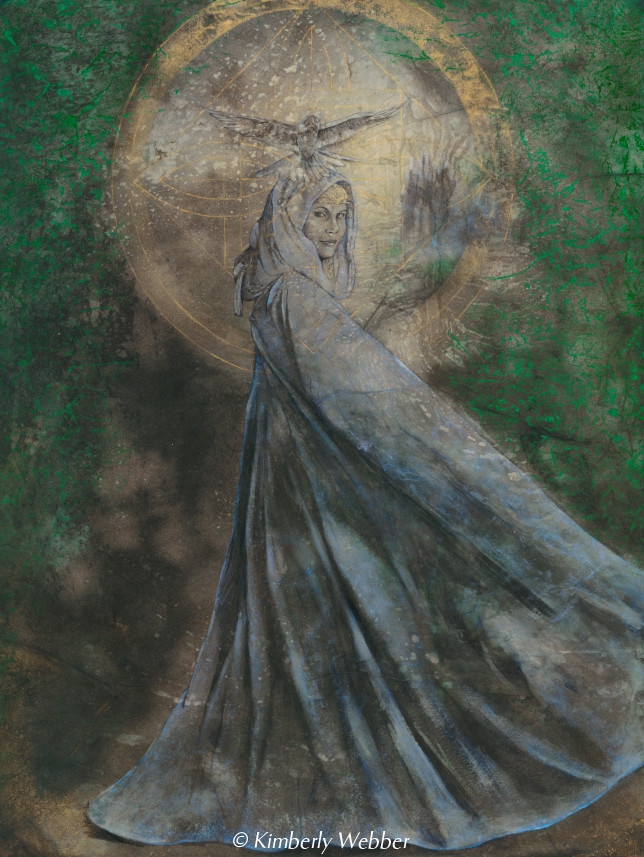
“I am grateful for an incredible circle of friends and colleagues”
“I am interested in natural materials not only for esoteric and aesthetic reasons but also for archival stability”
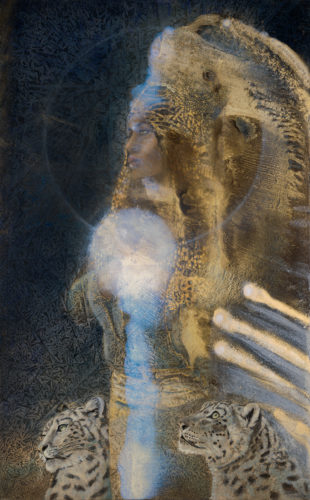
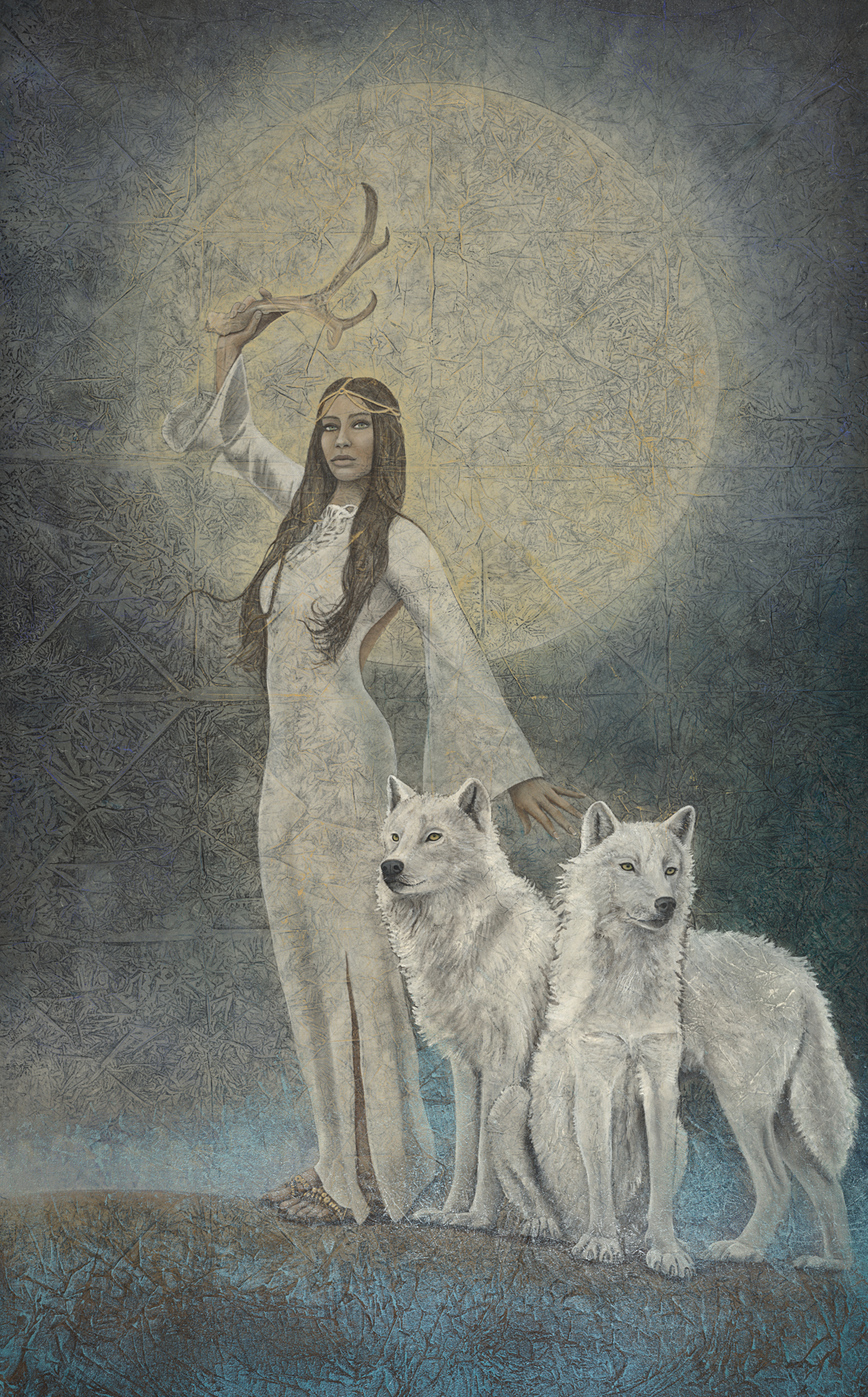
“Essentially my practice changed from shocking people awake to endeavoring to inspire them with beauty”
